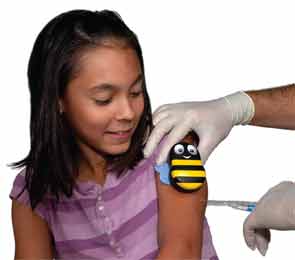
A Boon for Rheumatology Patients
Tracy Lovell, MD, a rheumatologist at the Northeast Georgia Diagnostic Clinic in Gainesville, Ga., says she suggests Buzzy to patients when they balk at giving themselves injectable medications. About 10 of her patients use the device, she says.
She says it can be particularly important in psoriatic arthritis patients who have failed infliximab (Remicade), since the only other good options in severe cases are injectable drugs like etanercept (Enbrel) and adalimumab (Humira). One patient with psoriatic arthritis flat-out refused to take an injectable until he saw how well Buzzy worked, essentially knocking out the pain completely.
“This is a good modality to make the patient more comfortable with accepting the therapy and also be comfortable with giving it to themselves,” Dr. Lovell says.
Buzzy works because of gate control, in which the sensations of the vibration and the cold of an icepack crowd out the sharpness of the needle and the burning feeling of medication being injected. The different nerves transmitting the sensation of vibration, cold, and the burning of the injection share a final common pathway—and, with the overstimulation with vibration and the cold, the sharpness of the injection is thwarted.
Dr. Baxter used the example of getting a burn on your hand and running it under cold water. “Immediately, the sharpness of pain is overwhelmed by the coldness and vibration,” she says. “That’s how Buzzy works.”
Adults are also helped by descending inhibitory control, a phenomenon not seen in young children. Dr. Baxter describes it as a powerful sensation—like putting your hand in a bucket of ice water—taking up so much “bandwidth” that you can tolerate more pain elsewhere. This coping device is developed as we age, and is also why adults can tolerate somewhat unpleasant tastes, like bitterness, more than children. Buzzy can be strapped on for shots in the arm, placed between the site of the injection and the brain. It can also be held in the palm and applied to the skin. It is typically held to the area for a short time before the injection to desensitize the nerves.
The vibrating mechanism in Buzzy is a flywheel motor with a piece of metal at the end of the motor that is off balance, so that when the motor spins the metal piece shakes and causes a high-frequency vibration. The motor is angled so that its energy is optimally directed to the nerves.

